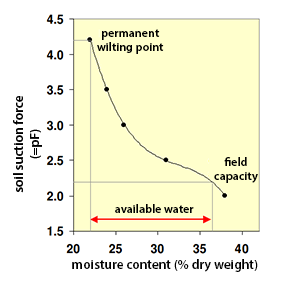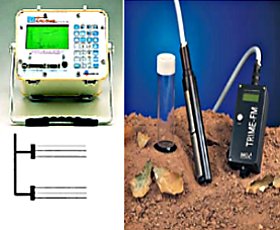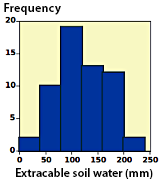
BILJOU
Forest water balance model
 - Silva Joint Research Unit
- Silva Joint Research Unit
Soil water reserve and root water uptake
What is the soil water reserve? How is this measured?
Soil water reserve is defined as the volume of water contained in the soil at a given time. This volume of water is generally expressed in the height of the water content (mm), easily comparable to that of rainfall and evapotranspiration. It is a dynamic variable that changes over time, influenced jointly by rainfall and evapotranspiration. However, all soil water is not available to be utilized by plants, either because the roots have not colonized the entire volume of the soil or because the water is too firmly retained by the soil to be extracted by the roots.
What is extractable soil water?
 An example of a clay-silt horizon water-retention curve (also called pF_humidity curve). High
levels of pF correspond to low moisture levels in the soil.
An example of a clay-silt horizon water-retention curve (also called pF_humidity curve). High
levels of pF correspond to low moisture levels in the soil.
How can water status and soil water reserve be measured?
The soil water status can be characterized in situ by considering the bond of water to soil particles (suction, also called water potential) or by the amount of water contained in the soil (humidity). Monitoring soil moisture levels over time can be achieved by taking direct measurements (mass humidity of soil samples), or through indirect measurements considering relationships between physical or chemical soil properties and its water content. Volumetric water content can be determined through neutron scattering measurements, electrical conductivity or dielectric constant measurements of the soil. The state of water binding is quantified by the soil water potential; negative when the water is bound to the soil and null when water is free. The amount of water (in mm) contained in a soil layer is equal to the product of the volumetric water content expressed as a percentage of its thickness (in decimetre). The soil water content is defined as being the sum of water contained in each layer of soil. However, as all soil water is not usable by the roots, it is never measured at zero as even under severe drought conditions, the remaining water is too firmly bound to soil particles.

Soil auger drill: a soil sample is extracted and weighed, then dried in an oven at 105 ° C to determine its mass water content
Two examples of equipment used to measure volumetric water content by the time domain reflectometry (TDR) measurement technique either by using waveguides inserted into the soil (left: Trase model) or by moving the probe to a tube (right: Trime model)


Neutron probe (Troxler) for measuring volumetric water content repeatedly over time at different depths by displacing the probe to an access tube
How is extractable soil water measured?
1. By measuring the total soil thickness containing fine roots. This is the first potential source of imprecision facing the forester. As such, direct observation of a trench wall often proves useful. In the absence of obstacles (slabs, stones) the rooting depth of adult trees usually measures at least 2 m.

Map of the distribution of fine roots, performed by counting the roots on a trench wall using a square grid measuring 10 cm x 10 cm. Colours indicate the different root densities.
2. By determining the porosity of the soil layers (horizons) by considering three distinguishable components: texture, coarse elements, structure. For BILJOU ©, it is also important to define the layer boundaries which will depend on the distribution of fine roots, which in turn determine physical constraints influencing their vertical distribution. In BILJOU ©, a layer is a hydrodynamically homogeneous compartment containing fine roots. Once the boundaries of the different soil layers have been identified, it may be useful to take a sample of fine soil to measure texture. This is usually detectable through touch.
3. By assessing the extractable water content in each soil layer in measured in millimetres, the point between the humidity percentage of field capacity and the permanent wilting point. In the absence of retention curves for the studied soil, extractable water can be estimated, as described above, by using tables (example below).
| Texture class (according to the Jamagne’s triangle) | % humidity of field capacity (pF = 2.5) | % humidity of permanent wilting point (pF = 4.2) | Available water (g water per 100 g of soil) | Bulk density ( dimensionless) | Available soil water reserve (water per cm of soil, mm) |
|---|---|---|---|---|---|
| S | 8 | 3 | 5 | 1.35 | 0.7 |
| SL | 12 | 5 | 7 | 1.40 | 1.0 |
| SA | 19 | 10 | 9 | 1.50 | 1.35 |
| LlS | 15 | 7 | 8 | 1.50 | 1.20 |
| LS | 19 | 9 | 10 | 1.45 | 1.45 |
| LmS | 20 | 9 | 11 | 1.45 | 1.60 |
| LSA | 22 | 11 | 11 | 1.50 | 1.65 |
| LAS | 24 | 12 | 12 | 1.45 | 1.75 |
| Ll | 17 | 8 | 9 | 1.45 | 1.30 |
| Lm | 23 | 10 | 13 | 1.35 | 1.75 |
| LA | 27 | 13 | 14 | 1.40 | 1.95 |
| AS | 33 | 22 | 11 | 1.55 | 1.70 |
| A | 37 | 25 | 12 | 1.45 | 1.75 |
| AL | 32 | 19 | 13 | 1.40 | 1.80 |
| A lourde | 29 | 18 | 11 | 1.50 | 1.65 |
Table of available soil water, from soil texture, Service soil mapping of the Aisne, Jamagne et al, 1977. Baize and Jabiol in 1995).
4. By gauging the bulk density of each soil layer. This can be measured in trenches using cylinders of established volume but can also be extracted from tables (example above). Care should be taken, however, when considering bulk densities of forest soils which are often quite different to those of agricultural soils: bulk density of forest soils often measures lower than that of agricultural soils due to their higher content of organic matter and to high biological activity. In contrast, forest soils may be more dense in depth than agricultural soils which are mechanically reworked. Bulk density tends to increase with depth.
5. By estimating the proportion of bulk elements or coarse-textured soil (% of soil volume).
6. By calculating the extractable soil water in each layer: extractable water x bulk density x (100 -% coarse elements) / 100
7. By adding these values taken throughout the entire depth of rooted depth
How is soil water absorbed by the root system?
The water potential gradient, primarily driven by transpiration, allows trees to extract water from the soil through suction. The soil water is absorbed by the non-suberized fine roots and will often function in association with mycorrhizal fungi to "drain" water to the roots.

Fine roots and mycorrhizae of laccaria fungi observed in oak in a forest soil using an endoscope (photo N Breda, 2008)

Extra-matricial hyphaes of a mycorrhizal fungus spread widely in the soil and increase the water and nutrients absorption area. Observations made in oak forest soil using an endoscope (photo N Breda, 2008)
The efficiency of a root system depends on: 1) its spatial extension particularly its depth, 2) its
water absorption capacity at low water potential (water firmly bound), 3) its potential for length growth,
especially when the soil is re-watered following a drought. The path of water (and of solutes) between the
soil and the tree is controlled by well-established biophysical laws, which are based on principles of liquid
phase diffusion in porous media and osmotic mechanisms. This path consists of three steps:
- water transfer into the soil in proximity to the absorbing root (a few mm to a few cm),
- radial water penetration into the root, across the epidermis-parenchyma - endoderm – stele cells,
- water transfer in the vertical elements of the root xylem and higher (trunk, branches, leaves).

Anatomical cross section of a root..
How is the soil water reserve used by trees ?
When the soil is wet, water is easily absorbed through light suction; the rate of absorption is proportional root density. As such, the upper soil horizons provide trees with more water than deeper horizons as this is where the majority of roots are located. During a drying period, absorption by the soil is initially evenly distributed to cover the whole rooted zone; water uptake is then limited to deeper levels where water binding to soil is less strong. During a period of severe drought, only the deepest layers of soil have the capacity to provide the tree with water. Transpiration flow, at this stage, is driven by a relatively low percentage of deep fine roots. The degree to which each soil layer contributes to the trees water supply varies according to season and depends on the facility of water extraction.

Variation in water uptake in different soil layers during drought development in an ash stand. Measurements were taken using a neutron probe. Right, distribution of fine roots in different soil layers of the same stand. (From Breda et al. 2002)
A few key figures

The figure below shows the distribution of extractable soil water in the permanent plots within the RENECOFOR network. These estimates represent soil descriptions and rooting depth; texture and coarse elements were then evaluated and textural coefficients were applied.
Useful References
![]() Badeau V, Ulrich E (2008) : RENECOFOR - Etude critique de faisabilité sur : la comparabilité des
données météorologiques « RENECOFOR » avec celles de Météo France, l’estimation de la réserve utile
en eau du sol et le calcul des volumes d’eau drainée en vue du calcul de bilans minéraux sur les
placettes du sous-réseau CATAENAT. Editeur : Office National des Forêts, Direction Technique et
Commercial Bois, ISBN 978 – 2 – 84207 – 323 – 7, 108 p. et 166 pages annexes.
Badeau V, Ulrich E (2008) : RENECOFOR - Etude critique de faisabilité sur : la comparabilité des
données météorologiques « RENECOFOR » avec celles de Météo France, l’estimation de la réserve utile
en eau du sol et le calcul des volumes d’eau drainée en vue du calcul de bilans minéraux sur les
placettes du sous-réseau CATAENAT. Editeur : Office National des Forêts, Direction Technique et
Commercial Bois, ISBN 978 – 2 – 84207 – 323 – 7, 108 p. et 166 pages annexes.
![]() Badeau V, Bréda N (2008) Modélisation du bilan hydrique : étape clé de la détermination des paramètres et
des variables d’entrée. RDV techniques hors-série n°4 – ONF.
Badeau V, Bréda N (2008) Modélisation du bilan hydrique : étape clé de la détermination des paramètres et
des variables d’entrée. RDV techniques hors-série n°4 – ONF.
![]() Bréda N, Lefèvre Y, Badeau V (2002) Réservoir en eau des sols forestiers tempérés : spécificité et
difficultés d’évaluation. La Houille Blanche, 3-2002, Forêts et Eau, 25-40
Bréda N, Lefèvre Y, Badeau V (2002) Réservoir en eau des sols forestiers tempérés : spécificité et
difficultés d’évaluation. La Houille Blanche, 3-2002, Forêts et Eau, 25-40
![]() Brethes A, Ulrich E (coordinateurs) (1997) RENECOFOR - Caractéristiques pédologiques des 102 peuplements du réseau. Editeur : Office National
des Forêts, Département des Recherches Techniques, ISBN 2 – 84207 – 112 3, 573 p.
Brethes A, Ulrich E (coordinateurs) (1997) RENECOFOR - Caractéristiques pédologiques des 102 peuplements du réseau. Editeur : Office National
des Forêts, Département des Recherches Techniques, ISBN 2 – 84207 – 112 3, 573 p.
![]() Quentin C, Bigorre F, Bréda N, Granier A, Teissier D (2001) Etude des sols de la foret de Hesse (Lorraine).
Contribution a l'étude du bilan hydrique. Etude et gestion des sols 8: 279-292.
Quentin C, Bigorre F, Bréda N, Granier A, Teissier D (2001) Etude des sols de la foret de Hesse (Lorraine).
Contribution a l'étude du bilan hydrique. Etude et gestion des sols 8: 279-292.
![]() Garbaye J, Guehl J M (1997) Le rôle des ectomycorhizes dans l'utilisation de l'eau par les arbres forestier. Revue Forestière
Française, XLIX n°sp 1997, 110-120.
Garbaye J, Guehl J M (1997) Le rôle des ectomycorhizes dans l'utilisation de l'eau par les arbres forestier. Revue Forestière
Française, XLIX n°sp 1997, 110-120.
![]() Bréda N, Zapater M, Barlet C, Lefèvre Y, Granier A (2008) Une pompe biologique performante : contribution des racines fines des
arbres forestiers dans le dessèchement des couches argileuses du sol lors d'épisodes de sécheresse. In: SEC2008-Volume 1,
International Symposium Drought and construction, Magnan J. P., Cojean R., Cui Y.J eds, Laboratoire Central des Ponts et Chaussées,
Marne-La-Vallée, 103-111.
Bréda N, Zapater M, Barlet C, Lefèvre Y, Granier A (2008) Une pompe biologique performante : contribution des racines fines des
arbres forestiers dans le dessèchement des couches argileuses du sol lors d'épisodes de sécheresse. In: SEC2008-Volume 1,
International Symposium Drought and construction, Magnan J. P., Cojean R., Cui Y.J eds, Laboratoire Central des Ponts et Chaussées,
Marne-La-Vallée, 103-111.
![]() Bréda N, Granier A, Barataud F, Moyne C (1995) Soil water dynamics in an oak stand. Plant and Soil 172(1): 17-27.
Bréda N, Granier A, Barataud F, Moyne C (1995) Soil water dynamics in an oak stand. Plant and Soil 172(1): 17-27.
![]() Cermak J, Prax A (2001) Water balance of a Southern Moravian floodplain forest under natural and modified soil water
regimes and its ecological consequences. Annals of Forest Science 58(1): 15-29.
Cermak J, Prax A (2001) Water balance of a Southern Moravian floodplain forest under natural and modified soil water
regimes and its ecological consequences. Annals of Forest Science 58(1): 15-29.
![]() Rambal S (1984) Water Balance and Pattern of Root Water Uptake by a Quercus Coccifera L. Evergreen Scrub. Oecologia 62: 18-25.
Rambal S (1984) Water Balance and Pattern of Root Water Uptake by a Quercus Coccifera L. Evergreen Scrub. Oecologia 62: 18-25.
![]() Vincke C, Bréda N, Granier A, Devillez F (2005b) Evapotranspiration of a declining Quercus robur (L.) stand
from 1991 to 2001. II. Daily actual evapotranspiration and soil water reserve. Annals of Forest Science, 62(7): 615-623
Vincke C, Bréda N, Granier A, Devillez F (2005b) Evapotranspiration of a declining Quercus robur (L.) stand
from 1991 to 2001. II. Daily actual evapotranspiration and soil water reserve. Annals of Forest Science, 62(7): 615-623

